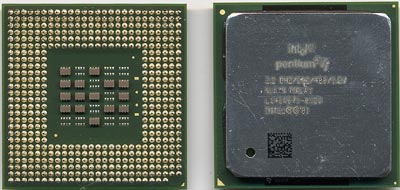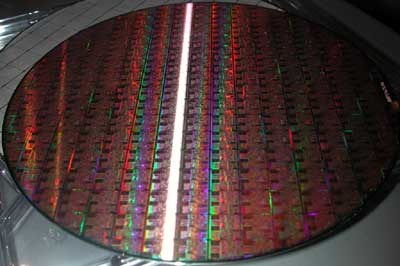AMD's Athlon XP 2000+ vs Intel's 0.13-micron Northwood
by Anand Lal Shimpi on January 7, 2002 4:16 AM EST- Posted in
- CPUs
Northwood - The Pentium 4 loses weight
Intel's release makes today a bit more interesting than your average speed bump story. The move to a 0.13-micron process means a lot for the Pentium 4 because when it was originally released as a 0.18-micron processor, it featured a core that was almost 70% larger than the competition. A larger core means that there is a greater chance of finding defects on a single processor thus lowering the yield of the part. A larger core also means that fewer CPUs can be produced per wafer also making the CPU a very expensive family member.

A close-up of a 0.13-micron Northwood core on a Si wafer
The 0.13-micron Northwood core addresses this issue first and foremost. While the original 0.18-micron Willamette die weighed in with a surface area of 217 mm^2, the Northwood is a meager 146 mm^2. On the current 200 mm wafers (see below), Intel can now produce approximately twice as many Pentium 4 processors per wafer than they could on the 0.18-micron process. And although that still makes it larger than the current Athlon XP core, the fact of the matter is that the core could have actually been smaller had it not been for one important performance improving characteristic of the new core.
The Pentium 4 has always been geared for what Intel has been calling the "future" of computing. While people will argue about exactly what that future will be, one thing is for sure, programs are constantly growing in size and the discrepancy between memory speed and CPU speed plays an even more important role as software becomes larger. Intel's decision was a simple but effective one; the Northwood core now features a 512KB L2 cache instead of the original 256KB cache. The addition of the extra cache raises the transistor count on the Pentium 4 to 55 million, up from the 42 million of the Willamette core.
The size of the execution trace cache has not been changed nor have any of the other units of the Pentium 4 core, but the increase in L2 cache will provide a tangible performance increase for most applications especially newer ones.
At the beginning of this article we mentioned that the 0.13-micron die shrink will also provide the Pentium 4 with more frequency headroom. The smaller transistors can switch faster and produce less heat than their older counterparts, paving the way for a 3GHz Pentium 4 before the end of the year. The current Northwood based Pentium 4s run at 1.50V and can already overclock beyond 2.5GHz with conventional air cooling, as the yields improve it shouldn't be too far fetched to see some near-3GHz speeds without much effort. Another aid in this effort to increase clock speeds is the fact that all 0.13-micron CPUs use Copper interconnects which as you may already know, AMD has been employing for some time now.
The Northwood core will eventually make it down to the mobile market as well, although at much lower clock speeds. There are still a few more pieces of the puzzle that must fall into place before this will be made a reality, such as the introduction of the i845G chipset (845 with integrated graphics).

Today Intel is releasing the first 0.13-micron Pentium 4 CPUs at two clock speeds: 2.0GHz and 2.2GHz. In order to differentiate the 2GHz CPUs from their older 0.18-micron 2GHz counterparts the new Northwood processors will be called the Pentium 4 2A; the 2.2GHz CPUs will simply be known as Pentium 4 2.2s. The Northwood will only be available in a Socket-478 variety (see above).
Since the processor has not changed much architecturally, we'll point you back at some previous articles for any further information you desire about NetBurst and the Pentium 4:
Intel Pentium 4 2.0GHz: The clock strikes two











0 Comments
View All Comments